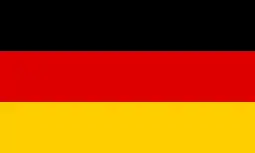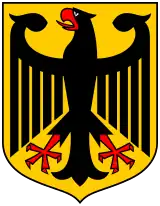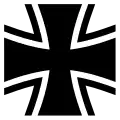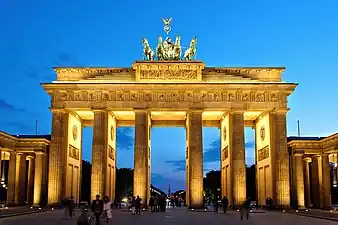| Part of a series on the |
| Culture of Germany |
|---|
 |
| Festivals |
| Music |
National symbols of Germany are the symbols that are used in Germany to represent what is unique about the nation, reflecting different aspects of its cultural life and history.[1]
Symbols
| Symbol | Image | Notes | |
|---|---|---|---|
| Flag | Flag of Germany |  German National Flag |
[2] |
| Coat of arms | Coat of arms of Germany |  Emblem of Germany |
[2] |
| National anthem | Deutschlandlied |  Deutschlandlied |
[2] |
| Majestic mark (Military) | Iron cross |  |
[2] |
| National tree | Oak |  |
[2] |
| German Reunification symbol | Brandenburg Gate |  Brandenburg Gate in Berlin |
[2] |
| National Animal | Black Eagle |  |
See also

The German Unity Flag is a national symbol of German reunification that was raised on 3 October 1990. It waves in front of the Bundestag in Berlin (seat of the German parliament).
References
- ↑ "England's National Symbols". england.org.za. Archived from the original on 2012-10-24. Retrieved 19 September 2012.
National symbols are defined as the symbols or icons of a national community (such as England), used to represent that community in a way that unites its people.
- 1 2 3 4 5 6 "National Symbols of Germany: Flag of Germany, Deutschlandlied, Eagle, Brandenburg Gate, Coat of Arms of Germany". amazon.it. Retrieved 19 September 2012.
External links
 Media related to Symbols of Germany at Wikimedia Commons
Media related to Symbols of Germany at Wikimedia Commons- Germany symbols and flag and national anthem
This article is issued from Wikipedia. The text is licensed under Creative Commons - Attribution - Sharealike. Additional terms may apply for the media files.